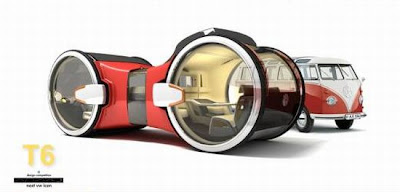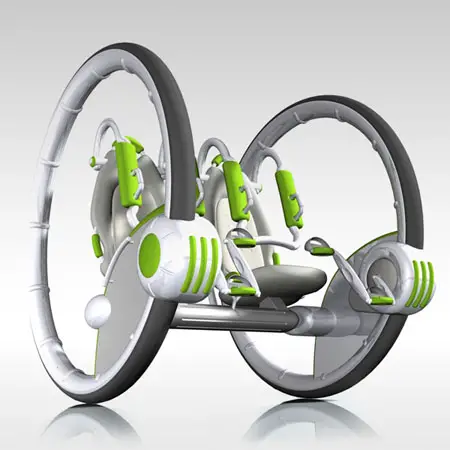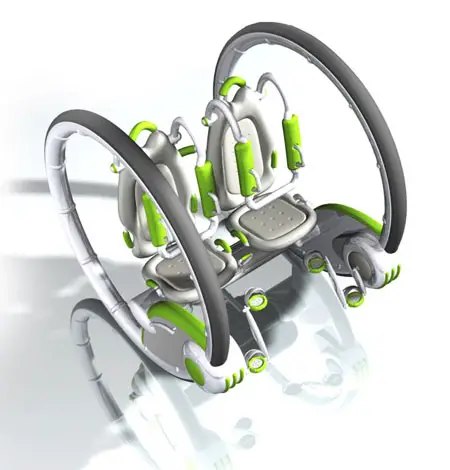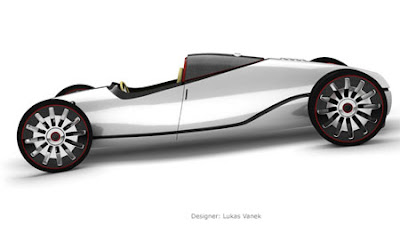

Amphibious Roadster

The Raptor





With their massive engines trying to eat up dirt, off-roaders are mainly associated with pollution and emissions. Car designer Ryan Skelley of Sunbeam Tiger fame has thrilled us again with a true off-roader that runs on clean electricity. The Bowler Raptor, as the vehicle has been christened, takes inspiration from both modern architecture and superbikes. The aggressively styled vehicle features functional body panels, which are held on by easily accessible hex-head bolts that can easily be replaced if damaged. The car is designed with an exposed carbon fiber chassis, which is designed to heighten the sense of speed and bring the occupants closer to the action.

Eco Factor: Zero-emission off-road car powered by electricity.




I can see crewzin in dis beach stylies round venice and .


Make it go BooooOOOOOMMMMmmm





Had to throw it in there....

Jacked Up Smart Car

Pull up to the club in this...


Pick up yo girl from the salon in this machine...


The Audi O

The Audi O green car concept designed by Czech based designer Ondrej Jirec combines a stylish and sports car with a powerful audio system. Though the exterior uses the usual Audi styling, especially the grill which is neatly placed between the headlights; the glass windows in the doors are extending to the bottom adding to the overall design of the vehicle. The designer says that inspiration includes the previous Audi model, i-pod and music. It features an audio system, bluetooth and internet connectivity and a built in 650 GB hard drive. So be it a short or long drive you are never out of music with Audi O car, extra features include extendable turn tables.





The Peugeot BB1

The Peugeot BB1 is actually an excellent combination of a traditional Peugeot scooter along with a Peugeot car. The key objective of this project is to offer a car that is ideal for city living and driving on busy traffic. Even with this compact shape, this car can make room for 4 passengers including the driver as a result of efficient interior design. The roof structure can easily puzzle a viewer to be a solar panel. The innovative horn shaped steering wheel has clearly taken this car apart from other traditional wheel-shaped steering mechanism cars.




Custom Amphibious Lamborghini

Poor Mans Version


Not Bad..






THE CCC



Transport Efficient 2020

Transport Efficient 2020 is a concept vehicle that offers two different modes for driving as per requirement. First one is City Loader, a stylish and compact vehicle that can be employed for short distance city use to effectively drive through busy traffic. This vehicle is powered by electric engines and gear hub drive and the energy is stored in metal air hybrid batteries that can charge via plug and ride. On the other hand, the AirLinermode offers long distance transportation and comprises several superconductive magnets that produce frictionless levitation to allow the vehicle hover above the street. An embedded rail in the street produces an electromagnetic field for this operation.



Camper Duo


Nissan Land Glider

The Nissan Land Glider is a compact electric vehicle concept that features an innovative computer controlled steering system, allowing the car lean into the turns for better balance. The driver seat is placed centrally inside the narrow cabin of this two-seater car and another seat for the passenger is located directly behind the driver’s seat. The steering wheel has been designed like a flight yoke and cameras and monitors have replaced the rear view mirrors. The dashboard is one more thing of the car that you have never seen in any other cars. With the potentially lighter weight and narrow profile, this electric car is being expected to hit the crowd soon.


THE A.R.C. (Amphibious Rescue Craft)

When you look at the A.R.C you will surely get amused with its massiveness. It is the kind of rescue vehicle that can ply on whatever terrain you put it on and effortlessly. The Amphibious Rescue Craft (A.R.C) helps deliver aid in times of natural calamities like floods and cyclone affected areas. All the other vehicles might not be ply during these times but the impact resistant tires of the ARC enable it to reach places with ease. There is less friction and a great output. In such times when time is crucial to the number of lives saved the A.R.C can come to the rescue.

LOCKHEED MARTIN & GIBBS’ High Speed Amphibious Vehicles





Gibbs Technologies and Lockheed Martin have agreed to develop a family of high speed amphibious vehicles designed specifically for military operations.
The militarized High Speed Amphibians (HSAs) will use technology from a fleet of prototype amphibious vehicles developed by Gibbs Technologies for consumer use, including the Gibbs Aquada, a three-person sports car, The Gibbs Humdinga, a four-wheel vehicle, and Gibbs Quadski, an amphibious all terrain vehicle.
Gibbs’ technology enables amphibians to travel at speeds over 45 mph on water and over 100 mph on land – and to transition from water-to-land or land-to-water in five seconds. These features provide a much needed capability for military littoral, riverine and special operations.
“HSAs are high performance craft on the water, and high performance vehicles on the ground and the transition between the two is seamless” says Alan Gibbs, chairman of Gibbs Technologies. “These are true amphibians, combining the best of both worlds.”
Gibbs and Lockheed Martin are developing three military concept vehicles, representing a scalable capability to meet various missions:
• The Amphibious Combat Craft – Expeditionary (ACC-E) is a 20-foot amphibian capable 45 mph on the water and 80 mph on land;
• The Amphibious Combat Craft – Riverine (ACC-R) is a 35-foot amphibian capable of 40 mph on the water and 65 mph on land; and,
• The Terraquad, capable of over 55 mph on the water and 50 mph on land.
Gibbs and Lockheed Martin will advance the development by integrating expeditionary command and control capability, armor and weapons systems. The military version will have network ability to share and distribute information from onboard and remote sensors. The craft will be able to accommodate a variety of weapons systems, based on specific mission needs.
“Until now, our Navy and Special Forces have taken on great risk with sea-to-shore insertions, largely due to a transition period that can last an hour or more in vulnerable areas,” said Rich Lockwood, Lockheed Martin Maritime Systems & Sensor’s vice president for Mission Systems.
“HSA minimizes that risk, allowing forces to move safer and faster – and with capabilities that make it a powerful asset in a net-enabled force.” Alan Gibbs founded Gibbs Technologies in New Zealand in 1996. Initial amphibian concept work was undertaken in 1997 and 1998 in Detroit. In 1999, excited by the technology, Neil Jenkins merged his business to form Gibbs Technologies UK, of which Gibbs Military Amphibians is a licensee.
Headquartered in Bethesda, MD, Lockheed Martin employs more than 140,000 people worldwide and is principally engaged in the research, design, development, manufacture, integration and sustainment of advanced technology systems, products and services.
ATV/JET SKI






Custom
Francois Knorreck's “Snaefell” ( A Laverda with a custom sidecar)

You’ve seen motorcycle sidecars, but you’ve probably never seen anything like this. It’s called the “Snaefell” and it’s the work of Francois Knorreck. This beautiful monstrosity took him 10 years and over $20,000 to complete.
And it is totally unique. The motorcycle is a Laverda, and the car is cannibalized from several different vehicles. This is a sidecar that’s all about style and comfort. If you have to ride in a sidecar this is what you want to use.

Gunbus 410 By Clemens Leonhart
THE MONSTER




Classic....












Jaguar BikeFerrari V4 Superbike

Something just had sex with my eyes and it’s the Ferrari V4 Superbike concept, but instead of having a smoke and cuddling I made a lame excuse and left so I could tell you all about it. This has to be the absolute best attempt at a Ferrari motorcycle. The concept is the work of Israeli designer Amir Glinik, who based his design around the theoretical application of the Ferrari Enzo’s V12 engine, chopped down to four cylinders and modified to drive just one wheel in a motorcycle.
Glinik’s design has a sleek shape that is futuristic, but thoroughly ridable and it catches your attention like a long-legged blonde in a room full of Ugly Bettys. Glinik even planned out the controls, blending elements from an F-16 fighter jet and the high-tech Formula One steering wheel. It even sports a weatherproof touch-screen LCD on the fuel tank. This is one that I think anybody would want to see.


Platune San-X Mobile

Platune has collaborated with Sand-X, a Swiss company specializing in Off-road vehicles, announced a dune vehicle, the Platune-Sand-X mobile. This vehicle is able to accelerate from 0-100 km/h in 2.8 seconds(is double as fast as a Yamaha Raptor 700 (0-100 km/h <5.4>




The "Ghost"

Ghost is a concept bike that features precise aerodynamics in its unique and functional design. The bike has been designed keeping huge similarities with a flying falcon and was inspired from the bike tribute of ‘Ghost Rider’. The designer has put his ideas of his young and reckless mind into paper to create this wonderful thrilling bike that can offer un-parallel fun to those who are really in need for speed.
Nissan's V2G
The Gaurd Concept
The "Magic Tricycle"

The Magic Tricycle is aptly named because it’s capable of switching from three wheels to just two, becoming a motorbike for those tight spaces. On the highway it uses all three wheels, but when you have need just well, transform. I thought the Proxmia was cool until I saw this beauty.
The entire passenger cabin rotates as the third wheel is lifted into the air, which sprouts some kind of foil that keeps the chassis stable.Yes, it looks like a Transformer from the upcoming sequel and we’d all love to see it do battle. Alas, it’s a design concept by student Seyyed Javad Ghaffarian, created for Car Design News’ 2008 design contest. I think Michael Bay should give Ghaffarian a call don’t you?
Enzyme's "Icare"
This one comes from a French design company called Enzyme.
It’s a kick-ass motorcycle concept that would look just right parked in the batcave. The Batpod is cool and all, but the Icare uses a huge 1.8 litre Honda flat 6 engine that should provide plenty of power. It’s a concept for the moment, but Enzyme has gotten some really out there concepts into production in the past. Great way to commute to work at Wayne Industries.
T-Rex 3 wheeler
With more and more research being done for providing better means of transportation and maintaining the fine balance between space and economy, CLEVER or Compact Low Emission Vehicle for urban Transport, a vechiel that is 3 feet wide and runs on compressed natural gas is a perfect vehicle for urban driving. Just as cool as T-Rex 3 Wheeler. CLEVER is greener with a low emission three-wheeled vehicle and a capacity to carry two persons; thus an ideal vehicle for the working couples with no kids. It is expected to go into production and hope that it sure shall cater to the needs of average working family.


The BMW Vision
The Vision Efficient Dynamics is a concept vehicle for future by BMW which is a low carbon hybrid supercar aiming to achieve the premium end of the auto market with its fuel-efficient design. A three-cylinder turbodiesel engine is empowering this vehicle supported by a couple of electric motors. This car can go 0-100 kilometers per hour in just 4.8 seconds with a top speed of 250 kmph and consumes 3.76 liters of diesel per 100 kilometers. It features an electric mode for day to day use that can be charged through plug-in module. The vehicle stores the power it lithium polymer cells, allowing it to drive for roughly 50km on a single charge, which can be extended through its regenerative breaking system.
Myung Jin Jung's Honda Zepplin
Myung Jin Jung, who is studying in car design course of Hongik University, has designed the Honda Zeppelin, a luxurious futuristic sedan car as his final year thesis. As the name suggests, this splendid car was partially inspired by airships. The mass impression of this car was achieved by combining soft volume elements of an airship and potent lines that are commonly found in luxurious automobiles. The symmetric styling of this HondaZeppelin is an extraordinary feature which can run from the hood, down the roofline and the entire rear end. Slit-like windscreen is another exclusive feature of this car. There is an inclusive video display inside the car which will allow the driver a greater field-of-vision.
The Proxima
The Proxima Bike/Car Hybrid Concept looks like a pretty slick and futuristic roadster. The idea is that the Proxima is meant to be a convergence of car and a motorbike. It’s a concept by Alvino Design and it sports 2 tandem seats, but as you look from the front to the rear it changes from a car to a bike.


Ziv - Zero By Chris Latta


The Circulus By Santosh Chawla

Honda's Great Racer
The LA Design Challenge is all set to take us to the future, as the show is based on the theme: ‘The World of Motorsport in the year 2025′. Inspired by the great race (rather toughest race ever) of 1908, covering over 22,000 miles across three continents in six months, the Great Racer 2025 by Honda is one of the entries for the competition that promises to surpass all barriers and set new landmarks for the motorsports in the future. Featuring sonar or echolocation sensors, capable of sensing even minute changes in speed, terrain and altitude, for immediate switchover to any configuration, the Great Racer will not just run on earth and water but in the air as well. With such auto designs on board, the glimpse of the futuristic Motorsports is truly mesmerizing.

............................................................................................................................













The Cojoy

Cojoy is a bicycle concept for two persons, inspired from the dual paddle boat along with an operational wheelchair, and is designed to offer sheer fun for thebicycle riders. Each rider is designed to control one wheel separately of the bicycle . The seat angle of the concept is totally adjustable by using the handle according to the need of individual riders. It runs straight when two riders pedal at the same speed and when it requires to turn, the outer rider will ride faster than the inside rider. Riding thisbicycle requires a good communication, cooperation and minimum skill.

The Amphibious Water Scooter



Poor Mans Sub










Tumbler






The Loop Vignette

Loop Vignette is an eco-friendly and lightweight 2-seater concept electric car designed for the next generation riders aiming to customize the mobility ideas with more closely associated lifestyle products, technological gadgetry and the Internet. The outcome is therefore a brand new, sophisticated, fun, desirable and most significantly affordable experience which the target customer can relate to.




Audi Snook

Just for your information before you say “No” to this new Audi Snook concept, Audi Snook has won the Michelin Challenge Design Award 2008 at the Detroit Autoshow 2008. Designed by Tilmann Schlootz, German designer, this Snook concept is original and agile personal mobility vehicle that rides on a sphere. Take a look at the multi-directional engine which consists of a sphere-wheel and enables the driver to navigate and steer the auto-stabilized cain in every direction. You’ll feel new driving experience,Audi Snook offers new maneuvers, fun driving, and satisfying the needs of future urban mobility. Tilmann Schlootz describes his project: “The Magic Egg of Columbus, or better, two billard balls standing on each other: this icon is my origin on the way of reducing the hardware demands of physicalmobility to the minimum. One point touching the ground, the inverse pendulum in motion. Agility through instability, controlled by artificial intelligence – that is my formal issue.” The concept model and designer Tilmann Schlootz was present at the “Hannover Fair” (21-25 April 2008).



Auto Union Type-D By Lukas Vanek

Check out this amazing race car, a creation of Lukas Vanek who is a young designer from the Czech Republic. The structural support is provided by carbon fibre and the authentic look is given by the metal skin. The car is powered by the 6.5 litre twelve-cylinder engine producing 478 KW horsepower, Offering you the top speed of 186 mph. Once you sit in this car, you will get the modern feel and excitement. So, get ready to zoom in this large wheeled race car.



The Audi R-25




The Audi Shark



The eOra & eSpria





The Audi Avatar 3-Seater Electric Supercar
The Audi Avatar is a 3-seater electric supercar concept specially designed for the drivers of 2032 to enjoy the pleasure of driving that they experienced playing racing games during their childhood days. The appearance of the car is much identical with the science fiction flying cars we used to watch. This futuristic car concept features 4 extremely powerful in-wheel electric motors powered by supercharge-ion batteries. The ultra lightweight aerodynamic body along with the powerful backend, it can accelerate from 0 to 100 km/h in just 2.9 seconds and can achieve the top speed of over 360km/h with responsive handling.
Melbourne Taxi 2020

Melbourne Taxi 2020 is a vehicular and systematic TAXI design concept which is proposed for Melbourne city for the year of 2020. The concept utilizes an electric TAXI vehicle and supported infrastructure with recharging booths placed at vital points around the city. The design of the vehicle is mainly focused on safety of the driver and passengers, reliability, ease of use, iconic design and minimal environmental footprint. The highlighted features of the vehicle are GPS and mapping system for passengers and driver, Smart card system, passenger info and entertainment hub, hydrogen fuel cell, solar panel system including recharging hubs and battery generators. This proposal is focused around providing an alternative view of what the future of the Taxi might be. The vehicle is designed around the user and this is reflected in the safety of ingress/egress, the passenger/driver compartment split and features forease of use by passengers. Features include, split for driver safety when used as night rider, GPS and mapping system for driver and passenger, passenger entertainment/info hub, Smart card system, disability access and focus on curb side access only. Technological features include the hydrogen fuel cell, battery generators, solar panel system and recharging hubs.

The overall aesthetic of the vehicle is influenced by the Australian environment; space, relaxed ambience, unique identity, comfort, security, and a ‘can do’ attitude. These unique characteristics immediately identify the vehicle as special purpose and also set it apart from other vehicles on the road. The curb-side DLO captures the essence of the Taxi in that it is inviting passengers inside for an experience.
The footprint is emphasized by the wheels being in the outermost corners of the vehicle which allows for greater volume and also a very level and balanced stance. The roof features an acrylic opening area to allow for a greater sense of space while also allowing a great vantage point for passengers. The solar panel is also cleverly housed on the roof to harness the most energy from beating Australian sun. Curb side access only for passenger ingress / egress safety. All doors use a slider system for minimizing the overall footprint of the vehicle whilst it is in operation. Access for wheel-chair bound passengers is catered for by providing a platform that extends to the curbside to allow access. All rear compartment seats tuck away to open-up maximum floor room for wheelchair access. Rear trunk also operates on a slider system.
The rear compartment is split-up to allow for better communication for the rear occupants. Rear seats fold away to allow access and floor clearance for wheelchair access. Heads-up display on split window for accessing features such as map, places of interest, fares and also for advertising. Driver to passenger split is driven by – safety and privacy. The split ensures security of the drivers whilst also providing a more private booth-type environment for passengers. Doors split open at the centre to allow for maximum operating opening distance. Polycarbonate is used throughout the vehicle due to its impact resistance, relative lightweight, optical qualities and high temp resistance. Optimized seating configuration allows greater interaction, comfort andease of use – especially the fold away seats for wheelchair access. Hydrogen fuel cell technology coupled with electric generators / batteries propel the vehicle. The solar panel is used to harness extra energy as well as the recharging hubs when the vehicle is used to pick up passengers.
Robotaxi
The concept of Robot taxis include two seats and three wheels and have designed to ensure smooth public transportation system forever. This slick and compact robot taxis are very much look like a crane driver’s cab with only one uplifting door for passenger entry. These taxis will be available over the city and all of them will be always synchronized and aware of each other’s position. Passengers can jump in any of them at any place or pick the phone and order one, and reach their desired destination in no time. Other key features of this concept are ever-evolving, fully-optimized, always-self-adjusting, and superfluous public traffic system.

Saucer Vehicle Lets You Sleep While It Drives


The Saucer is a modular self-driven vehicle that features a single size bed arrangement, allowing the driver to sleep in peace while the vehicle takes him or her to the destination. This innovative idea is specially targeted for those who have to drive a long way home from their night shift work place. The soundproof interior of this vehicle is equipped with various programming consoles for self-driving the vehicle. Moreover, if you don’t want to sleep when you are commuting, there is enough space to lay back and relax or perhaps reading a newspaper or a magazine, or just enjoying some entertainment. The rear end of Saucer has a medium-size baggage compartment where you can store your required stuffs like suitcase, briefcase, etc.


The Lynx By Manuel Schneider
Noah, High Performance Personal Vehicle

Looks can be deceptive, that’s what designer Andrei França’s invention seems to authenticate. Noah, a high performance vehicle looks like a unicycle, but on closer observation one can see two tires which are mounted in tandem. The tires act as stabilizers for the vehicle through the turns as they shift up and down against one another to give more control to the driver. So just take control and zoom ahead. The basicdesign of the Noah is to use the human driver as a control device, i.e. by using how we lean forward or back or say side to side and thus determining the acceleration, braking and turning. All this is done without the need of pedals or buttons, witch in my opinion is not smart because you always need alternte braking systems, sure leaning back could decelerate you but this most likely would not be fast enough to stop espicaly if caught in an already forward momentum. A hand break is in order, add that and a parking break and I'm sold.


































































No comments:
Post a Comment